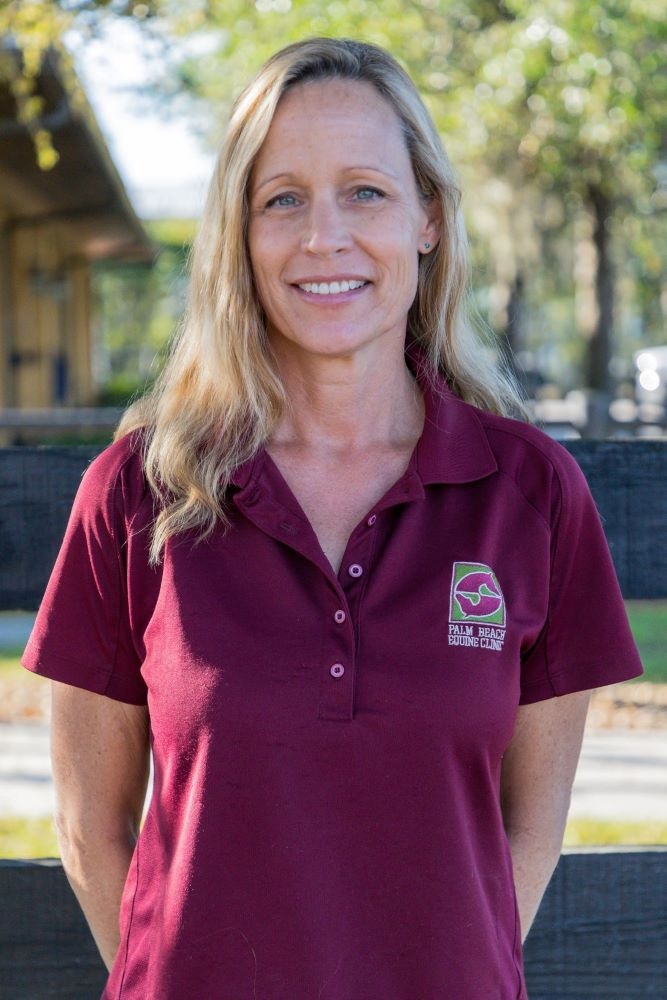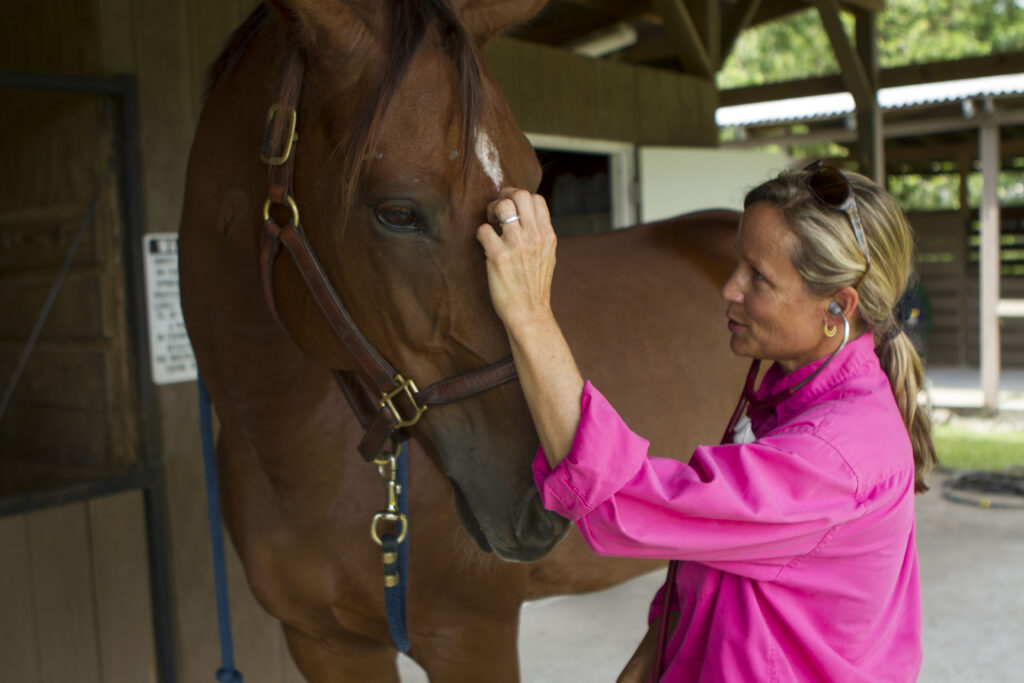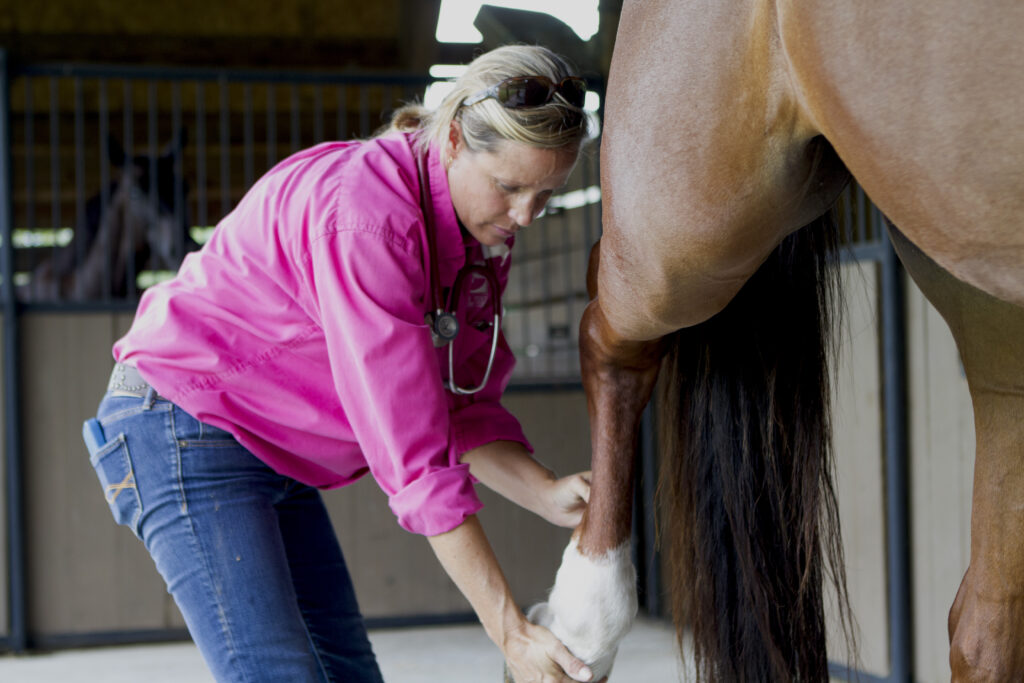Palm Beach Equine Clinic is renowned for its full-service surgical center and intensive care hospital located in the heart of Wellington, Florida. Board certified surgeons, primary care veterinarians and hospital technicians are scheduled 24 hours a day, 365 days a year to treat, monitor and care for critical cases. With world class veterinarians and a full staff of highly trained technicians, both clients and patients of Palm Beach Equine Clinic are in the best hands possible.
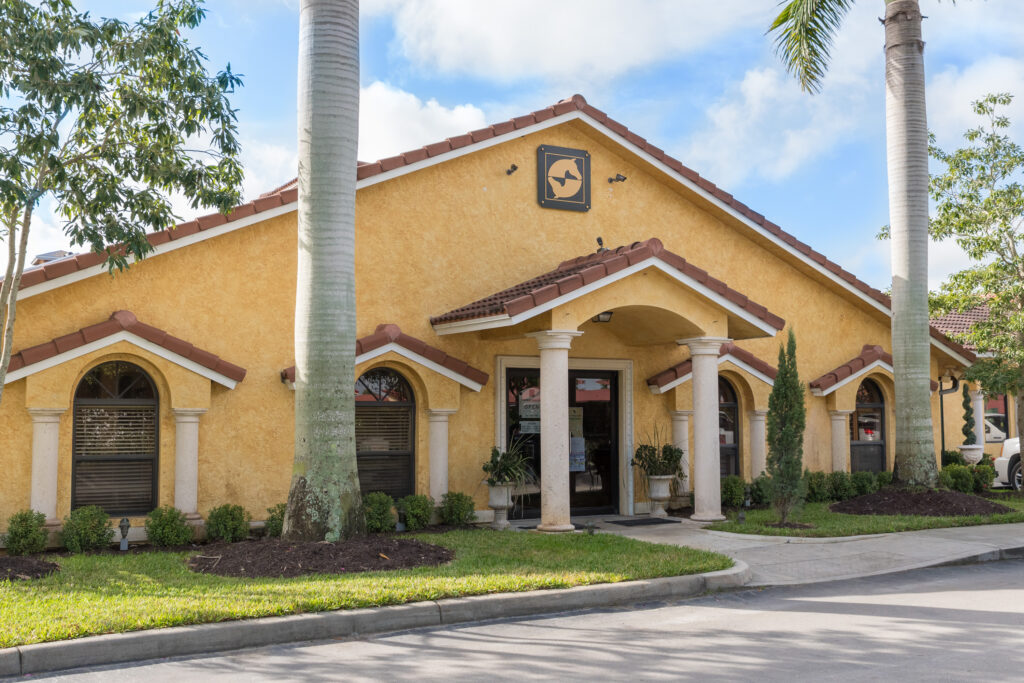
Equine Hospital and Surgical Facility
Palm Beach Equine Clinic’s surgical suite and staff is prepared to handle all kinds of emergencies, day and night. The large team of 26 veterinarians includes three Board Certified Surgeons who rotate on-call duties for all emergencies. This aids Palm Beach Equine Clinic veterinarians and all of the Southeast with the ability to treat their emergencies quickly, especially any requiring surgical assistance. The state of the art intensive care hospital is equipped with digital video cameras for the clinicians to easily monitor their patients from any location, at any time. Palm Beach Equine Clinic also has a full-service laboratory on-site equipped with hematology, chemistry, and microbiology equipment to internally evaluate each case and provide rapid results.
Advanced Diagnostic Imaging Capabilities
Palm Beach Equine Clinic prides itself as a consistent leader in horse sport medicine and recently upgraded its scanning technologies to provide better equine diagnostic imaging services for their clients.
Last fall, Palm Beach Equine Clinic installed a state-of-the-art MRI lab containing the Equine Standing MRI manufactured by Hallmarq, which allows scans of the equine foot and lower limb to be done in a standing position requiring only light sedation. Additionally, last year Palm Beach Equine Clinic completed the renovation of a Nuclear Scintigraphy lab with the installation of the new top of-the-line MiE Equine Nuclear Scintigraphy camera. This new gamma ray camera is designed with sharper contours for more precise imaging and lameness diagnosis. The advanced technology provides the ability to acquire high quality images regardless of small patient movements, alleviating the necessity for re-scans and reduces the time required to complete a scan. Both MRI and Nuclear Scintigraphy can be extremely useful in diagnosing lameness origins and determining appropriate, effective treatment for your horse. Palm Beach Equine Clinic has a Board Certified Radiologist on site to interpret images to assist with diagnosis.
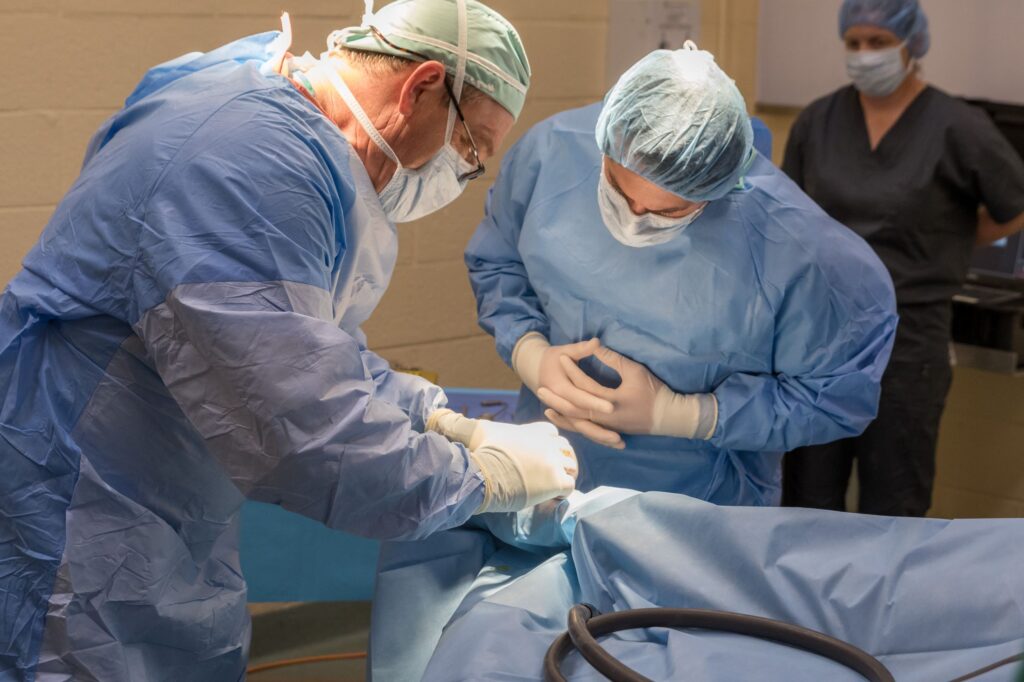
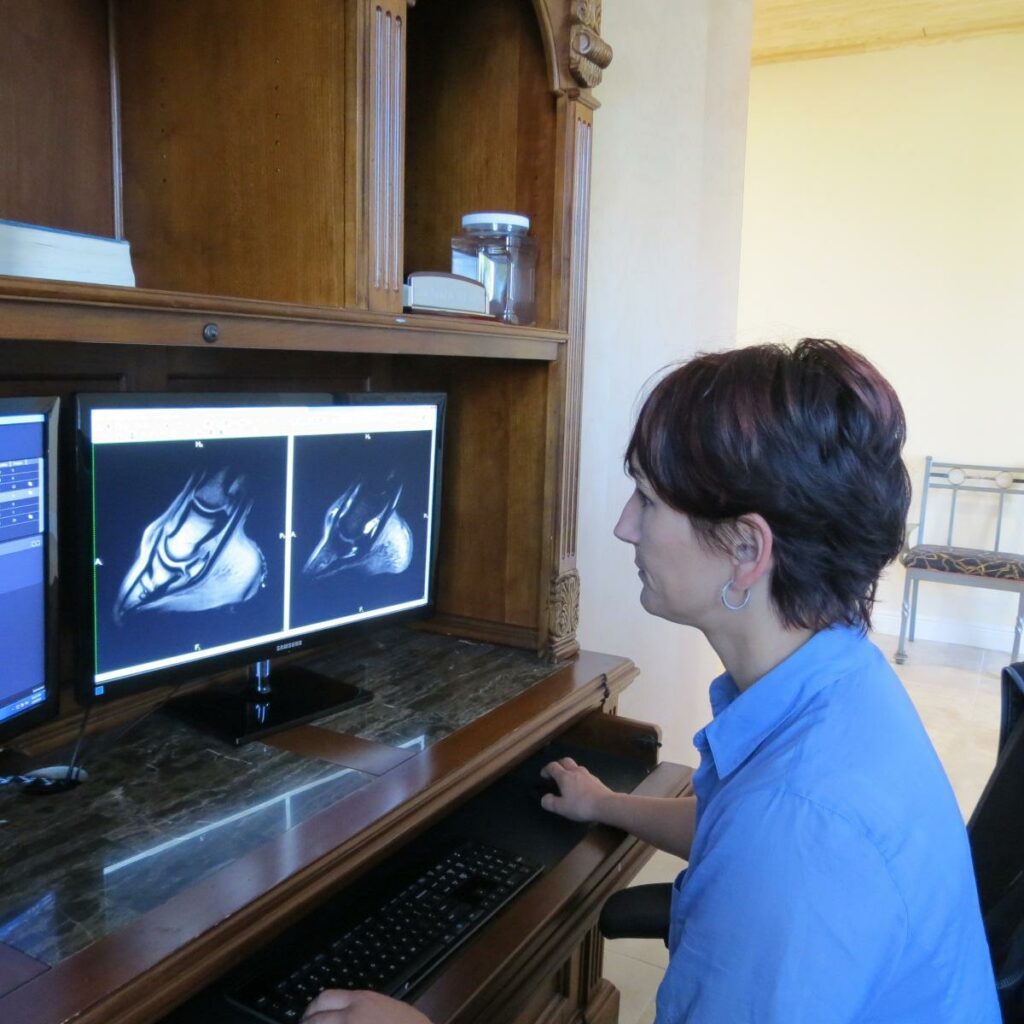
For Palm Beach Equine Clinic, 2016 will be an exciting year for expansion of our physical facility. PBEC plans on adding an additional 4,000 square feet of air conditioned examination areas, an additional surgical suite and recovery stall, as well as, climate controlled isolation quarantine stalls. Under the guidance of Dr. Sarah Puchalski, our in house Board Certified Radiologist, Palm Beach Equine Clinic hopes to add the first equine Computed Tomography service (CT scans) to our diagnostic imaging expertise.
Consult Palm Beach Equine Clinic for your Horse Health Needs
For more information on our facility or in case of an emergency, please call (561) 793-1599 to contact an on-call veterinarian.
Learn More About Surgeon Dr. Weston Davis
Dr. Weston Davis is a second-generation veterinarian from South Florida. His father is recently retired from veterinary medicine and his family raises beef cattle in Clewiston, FL. Dr. Davis graduated Magna Cum Laude from the University of Florida College Of Veterinary Medicine in 2008. He was awarded the Barbaro Gulfstream Scholarship (a veterinary scholarship named in honor of the amazing Barbaro), the Calder Race Course Scholarship, and the Student Award for Excellence in Large Animal Surgery.
After graduation, Dr. Davis completed his internship in Sports Medicine and Surgery at Oakridge Equine Hospital, followed by a residency in Equine Surgery at North Carolina State University. In 2012, he became board certified in Large Animal Surgery by the American College of Veterinary Surgeons. Before joining Palm Beach Equine Clinic, Dr. Davis spent 1.5 years as a staff surgeon at a private practice referral center in Texas. He has authored and co-authored publications on topics ranging from colic surgery to advanced imaging and novel surgical techniques. In 2014, he was awarded the BEVA Trust Peter Rossdale EVJ Open Award for a research publication on return to performance following colic surgery. He has spoken at several national and state meetings.
Dr. Davis is an avid sportsman himself, and his hobbies include fishing, hunting, waterskiing and almost any outdoor activity.
Tell us more about your background with horses growing up?
I started riding horses when I was so young I can’t remember. We had some amazingly kind horses that packed us around and took care of us (and a couple that didn’t). Riding as a child was mostly business – for the purpose of working cows. Somewhere around 14, I began team roping for pleasure and competition. I roped throughout college, but lost the required free time when I began practicing veterinary medicine. I’ll probably get after it again when I am retired and much too old to be doing that sort of thing!
When and why did you decide to become a veterinarian and why did you choose to pursue a career in surgery?
I decided to be a veterinarian very early in life.I had a father and uncle who were both successful and happy veterinarians whom I looked up to, so it was a logical path to follow. The surgical interests started as a kid watching my father do surgery, something I always thought was amazing and he was very skilled at. My decision to pursue the surgical avenue came during vet school when I realized that I wanted to specialize and knew surgery was my passion.
What is the best advice that your father has given you as a veterinarian?
My father is a man of few words. However, by watching him, I learned one of the biggest life lessons, which is to be calm and content with your career and your life.
What do you enjoy about speaking publicly and sharing your knowledge?
I think mentoring, sharing knowledge and teaching the hands-on skills to the next generation of veterinarians is one of the most fun and rewarding parts of my job. Observing a student as content and excelling in their career with a skill set that you contributed to, even in a small way, is a beautiful thing.
What is the most interesting or rewarding surgical case you have worked on?
Although minimally invasive arthroscopic type surgeries are my favorite to perform, I think colic surgeries are one of the most rewarding. They are often difficult surgeries and inevitably in the middle of the night, but you take a horse who would most certainly die without you, and save a life. Helping a horse who was in excruciating pain or has a life-threatening devitalized piece of intestine recover back to feeling comfortable and eating in their stall the next day is about as good as it gets.
What are your goals for your career now?
My goal is to expand the surgical and outpatient sports medicine referrals at PBEC. I am currently the coordinator for the intern and resident program. I plan to expand and improve on the quality of these mentoring programs within the industry. I am also working on the development and description of some novel minimally invasive surgical techniques. I aim to continue authoring 1-2 publications annually in the refereed equine literature.
When not roping, fishing, hunting or water-skiing, what other things do you do with your free time?
Most of my non-equine time lately has been devoted to some real-estate interests and house renovations. I am also a big reader.
Palm Beach Equine Clinic is proud to be the Florida distributor of DJM Sole Supports. DJM Sole Supports can safely be used to give instant relief for many common hoof ailments in horses. They are especially helpful for horses suffering from laminitis, punctured soles, infections, foot abscess, pre- or post-surgery support, foot and heel soreness, sole pressure related issues, barefoot trims and extra support to travel long distances.
Facts about DJM Sole Supports
DJM Sole Supports are 100% breathable, easy to apply and provide instantaneous relief due to uniform support for the entire foot. The supports can be used in conjunction with any medicated gel to help an injury or infection. Once the pad has formed its shape, it will not alter.

The supports can be washed in warm salty water, allowed to dry naturally and reused for up to two weeks. The pads can also be left on for several days at a time. However, if there is a discharging wound, the pad should be removed, cleaned thoroughly and reapplied every 24 hours.
The DJM Sole Support engineering was developed by farrier David Mangan, who now solely devotes his time and knowledge into designing innovative products for horses. The Sole Support is unique and superior to other products due to its patented composition. When a horse’s foot is sore and inflamed, the sensitive laminae swells, causing pain from any load or movement. The DJM Sole Support aids in reducing the sole’s movement, evenly distributes the pressure and minimizes the downward movement of the sole from loading.
Proper Application of a DJM Sole Support
Proper application of a DJM Sole Support will give rapid relief to the horse in a majority of cases. In the case of Laminitic horses, DJM Sole Supports can provide relief by supporting the sole to reduce the pull of sensitive inflammatory tissues (Laminae) as it separates from the hoof wall. Sole Supports can also offer full protection and comfort while travelling long distances by trailer or plane. Horses that are preparing or recovering from surgical procedures can benefit from the use of Sole Supports to reduce the loading on supporting limbs and stabilize the injured leg. In cases where horses suffer from corns or stone bruises, the Sole Support can reduce inflammation, provide protection and comfort with, or without, a shoe. The supports will also give instant relief to horses that are sensitive to shoeing and typically require a few days to recover. The sole supports are an excellent, clean alternative to “hoof packing” after a hard day’s work. Additionally, for horses that have lost a shoe and rely heavily on those shoes for soundness, the Sole Support may be used to protect the foot while waiting for the farrier to arrive.
DJM Sole Support pads are available in three sizes to fit most horses.
If the pad is larger than the foot, it is safe to allow excess to cover the heels and or provide a rolled toe. The support pads are available in either “soft” or “firm” types, with the softer compound more suitable for the very tender footed horse.
Always on the forefront of medical advances, Palm Beach Equine Clinic is proud to distribute DJM Sole Supports in Florida. For more information, please visit https://paniolo.online/product/sole-support/ or call the experts at Palm Beach Equine Clinic at 561-793-1599.
The Growth of Palm Beach Equine Clinic
Jump Media interviewed Dr. Scott Swerdlin, DVM, MRCVS, and President of Palm Beach Equine Clinic to learn more about the Clinic’s simple beginnings and evolution into one of the largest veterinary practices in the United States.
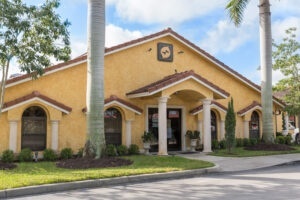
What was the genesis of Palm Beach Equine Clinic? Why was it started, how big was it, how many vets worked in the beginning, what kinds of services were offered?
In 1979, Dr. Paul Wollenman came to Wellington, Florida to principally care for Lion Country Safari’s exotic animals. Dr. Wollenman started to build the physical structure of Palm Beach Equine Clinic in 1981. I joined PBEC in 1983 and it was the beginning of a remarkable partnership. Mine and Dr. Wollenman’s strengths complemented each other well. I had recently resigned my Captaincy in the United States Airforce Veterinary Core and was excited to come back to where I grew up.
In 1991, we enticed Dr. Robert W. Brusie to join us from his successful surgical practice in Atlanta, GA. Dr. Brusie joined us to build the modern foundation of Palm Beach Equine Clinic. I was extremely fortunate to have these two extraordinary veterinarians as mentors. Shortly after Dr. Brusie joined us, we had an exceptional surgical service routinely treating colic cases and performing orthopedic surgeries. The final piece of the puzzle was to bring on a remarkable veterinarian from the next generation. We found that missing piece in 2003, when Dr. Richard Wheeler joined the team.
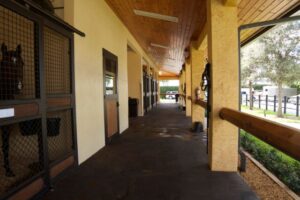
When did PBEC evolve into its current state?
The evolution of Palm Beach Equine Clinic has been constant and ever increasing. The growth of Palm Beach Equine Clinic mirrored the growth of the show horse industry through 2005. Ten years ago, we witnessed an exponential growth in the dressage discipline. From our simple beginnings, we now have twenty-eight veterinarians. What I take great pride in is my job is to keep twenty-eight veterinarians happy and explore additional opportunities to continue to grow and improve. Almost 30 years ago, Palm Beach Equine Clinic bought the first ultrasound for equine practice in South Florida. Twenty-five years ago, Palm Beach Equine Clinic installed the first gamma-ray camera to perform bone scans (Nuclear Scintigraphy). Twenty years ago, we developed Computed Radiography (CR) for horses. Currently, Palm Beach Equine Clinic has the most advanced state-of-the-art surgical and diagnostic imaging equipment for the horse. Onsite, we have a Hallmarq standing MRI unit, MiE gamma ray camera, Digital Radiography, Video Endoscopy, and a bevy of additional diagnostic equipment. Palm Beach Equine Clinic is dedicated to providing exceptional veterinary service for the horse.
What are the most important parts of PBEC?
No question, it is our staff. Palm Beach Equine Clinic is dedicated to providing a culture of respect and excellent communication. Palm Beach Equine Clinic encourages every technician and employee to embrace their position not just as a job, but as a career. Many of our technicians and administration staff have been a part of Palm Beach Equine Clinic for over 10 years. I want every person who works here to feel as though they are part of a team. Unequivocally, the most important part of Palm Beach Equine Clinic is its family of employees.
How was PBEC changed in the past several years?
Over ten years ago, we were fortunate to have Dr. Bill Patterson, Dr. Gary Priest, Dr. Bob Smith, Dr. Hilary Clayton, Dr. Jordan Lewis, and Dr. Kathleen Timmins join Palm Beach Equine Clinic to contribute to the culture and the success that we currently enjoy. In the past several years, we have added multiple, additional extraordinarily talented veterinarians. Dr. Jorge Gomez, Dr. Weston Davis, Dr. Sarah Puchalski, Dr. Bryan Dubynsky, Dr. Janet Greenfield, Dr. Tyler Davis, Dr. Daren Tamplin, Dr. Natalia Novoa, Dr. Ryan Lukens, Dr. Selina Passante-Watt, and Dr. Sarah Allendorf have all recently joined the Palm Beach Equine Clinic team within the past five years. We have updated all of our technical capabilities and we have added an Annex Office on the WEF show grounds in Wellington, Florida.
What do you see PBEC adding in 2016?
For Palm Beach Equine Clinic, 2016 will be an exciting year for expansion of our physical facility. Palm Beach Equine Clinic plans on adding an additional 4,000 square feet of air conditioned examination areas, an additional surgical suite and recovery stall, as well as climate controlled isolation quarantine stalls. Under the guidance of Dr. Sarah Puchalski, our in house Board Certified Radiologist, Palm Beach Equine Clinic hopes to add the first equine Computed Tomography service (CT scans) to our diagnostic imaging expertise.
Is there anything else you would like to add?
Palm Beach Equine Clinic owes all of its success to the horsemen and horsewomen of South Florida. We thank you for trusting our Doctors and staff with your precious family member, your horse. PBEC Veterinarians volunteer their time for many projects in our community. It is our pleasure to support Vinceremos Therapeutic Riding Center, Charity Challenge, One World, and many other local charities. Our doctors also contribute their time to providing veterinary care for the Winter Equestrian Festival and Global Dressage Festival as the Official Veterinarians. Palm Beach Equine Clinic is dedicated to providing exceptional care to your horse and is committed to improving our relationship with our clients, as well as our community.
Meet Dr. Janet Greenfield-Davis
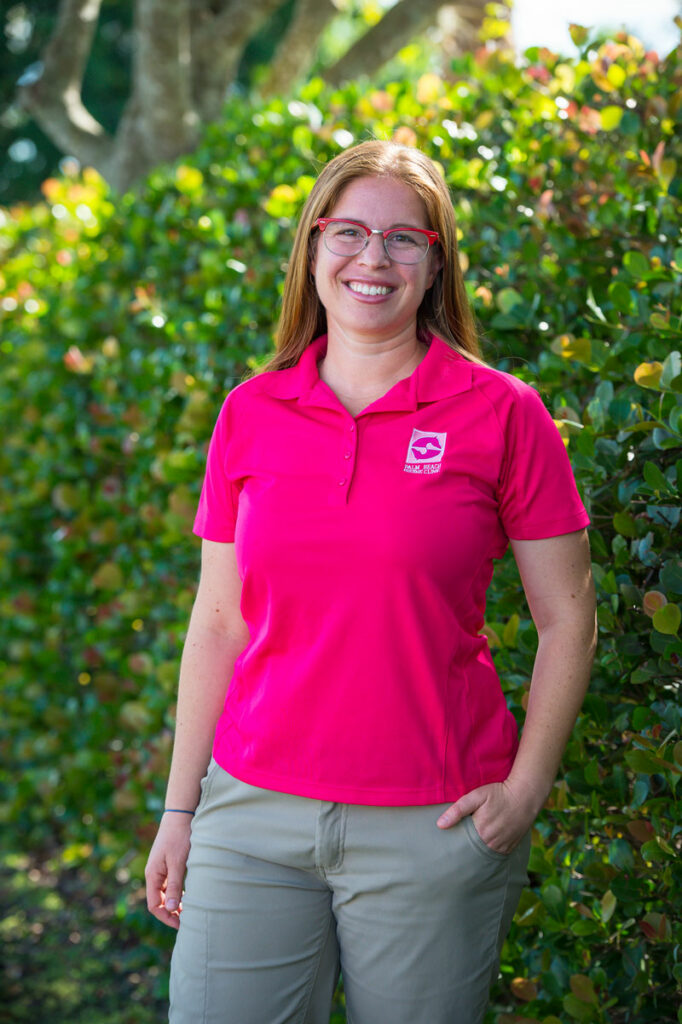
Dr. Janet Greenfield-Davis knew she wanted to be a veterinarian since elementary school. She grew up riding and competing on the hunter/jumper circuit in California before attending California Polytechnic State University and graduating from the University of Glasgow School of Veterinary Medicine in Glasgow, Scotland. Working alongside her husband Tyler Davis, Janet joined the Palm Beach Equine team as an intern before accepting a full-time position in 2010.
What inspired you to be a veterinarian?
I started riding at eight years old in a little field at the end of my street. As I started to grow up, my dad got me taking lessons and competing. He asked me one day when I was 11, ‘What do you want to be when you grow up’? I told him that I wanted to be a veterinarian and work on horses. He never let me forget that, so I grew up and became a veterinarian.
What is it like to work with your husband every day?
It’s wonderful. How many people can say that they get to see their significant other throughout the day, work on cases together, and bounce ideas off each other? We have worked together since the day we met. We went to school together, sat together in class and now we work together. I absolutely love it.
Have your children inherited the animal-lover gene?
Oh yes! We have two girls – Zella is two and Maisie is five months. Zella comes on calls with me regularly. She has her own toy stethoscope in my truck.
What is your specialty?
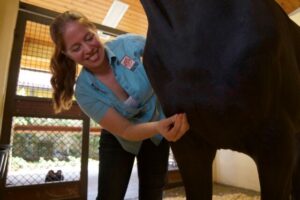
I specialize in acupuncture and herbal medicine. Both piqued my interest in vet school, and when I came to Palm Beach Equine, there was an opening for an acupuncturist. I really love having a way to treat animals without using drugs or steroids. It’s one more method to help equine athletes reach peak performance and is gaining more and more popularity. When I first started, people didn’t embrace it as much, but now even more doctors are starting to turn to it for cases they are not sure how to diagnose. With all the strict rules in FEI, it is a way to make a horse feel better without using drugs.
When you are not working, where can we find you?
Hanging out with my kids and my husband. We try to do family things as often as we can.
What advice would you give to someone considering vet school?
It’s a long, hard road but if you love it, it is so worth it.
What do you like about being on the Palm Beach Equine team?
We have all the diagnostic equipment we could ever need, and I love the quality of practitioners that we have at our practice. We always work as a team – everyone’s number-one goal is the best care for horses and animals in general.
Name one thing most people don’t know about you?
I used to swing dance. I taught lessons and performed for a long time.
Jo Ann Hopkins and her 12-year-old Appendix-bred gelding, Blazer, were placed third in points in their local 1D barrel racing circuit. However, three months earlier, Blazer underwent surgery at Palm Beach Equine Clinic for a growing cyst in his sinus. On August 1, 2015, Dr. Weston Davis, DACVS, performed the surgical procedure on Blazer for an expansile paranasal sinus cyst of the left paranasal sinuses, extending to the right concho-frontal sinus.
Hopkins noticed that Blazer, who she calls “George” for his laid-back attitude, had a raised knot on his head this spring and consulted with her local vet, Dr. Kelly Alderman. The area was monitored closely and remained in a similar condition until June, when Hopkins noticed Blazer wheezing while running barrels and the knot increasing in size.
Diagnosing the Paranasal Sinus Cyst
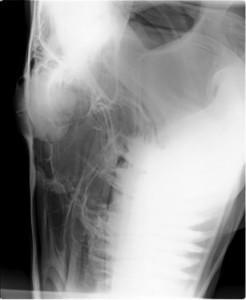
Dr. Alderman performed radiographs on the site and aspirated the swelling where a substantial amount of fluid was removed. She confirmed that the bump was a suspected paranasal sinus cyst. At that point, Blazer was referred to Dr. Weston Davis of Palm Beach Equine Clinic, who advised Hopkins that the cyst was likely growing slowly within the sinus for a considerable amount of time with no clinical signs. The diagnosis was an expansile paranasal sinus cyst of the left paranasal sinuses, extending to the right frontal sinus.
Paranasal Sinus Cyst Surgery
For surgery, Blazer was placed under standing sedation and local analgesia (painkiller) and his head was aseptically prepared before Dr. Davis performed a frontonasal sinusotomy (incision into the sinus). He made an opening from the middle of Blazer’s head to the corner of his eye. Once the skin flap was elevated and the bone fractured, a large amount of fluid was evacuated, which is consistent with the contents of a paranasal sinus cyst. Dr. Davis also observed that the sinus cavity was extremely distorted and expanded. The cyst lining was debrided and removed, then the sinus was lavaged and a tube was advanced into the sinus cavity to facilitate drainage. The sinus was packed with gauze tied together and soaked in a dilute betadine. Finally, the bone flap was replaced and the skin was closed and covered with a sterile bandage.
Recovery
The gauze packing was removed 48 hours after surgery and upon release from Palm Beach Equine Clinic, Hopkins was instructed to monitor the incision for heat, swelling and discharge. Bute, in the amount of 2g, was administered orally once a day for five days and Dr. Alderman removed the sutures after 10 days.
Hopkins characterizes Blazer as a sweet gelding with heart to spare, and is happy to report that his recovery has been fantastic. After six weeks of stall rest and rehab time to get back in shape, Blazer recently won his first barrel race after surgery. According to Hopkins, Blazer is running better than ever thanks to Dr. Davis and the staff at Palm Beach Equine Clinic.
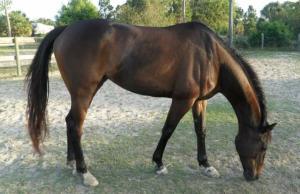
Palm Beach Equine Clinic is renowned for its exceptional care of performance sport horses of all disciplines around the world. Sometimes, the veterinarians and surgeons have the opportunity to treat the horses owned by their colleagues. This summer, Palm Beach Equine Clinic veterinary technician Megan O’Neal experienced the clinic’s surgical expertise firsthand when her rescued off the track Thoroughbred (OTTB) was diagnosed with severe spinal impingement (kissing spines).
Signs and Symptoms
O’Neal adopted Blessing, a 10-year-old mare, almost three years ago. After Blessing’s career on the track ended, she was given to Pure Thoughts Horse Rescue in Wellington, FL. Blessing had moved through a few foster homes before O’Neal gave her a forever home. Blessing had been successfully jumping three-foot courses with one of her previous foster homes. After adopting Blessing, O’Neal was jumping the mare as well, but only about two-feet high. She had plans to compete, but Blessing’s behavior changed under saddle. The mare began rearing and bolting, endangering both herself and her rider. Her attitude on ground handling turned sour as well, no longer enjoying being groomed and pinning her ears in agitation.
Identifying the Problem

With the help of Palm Beach Equine Clinic surgeon Dr. Weston Davis and the advanced imaging technology available at PBEC, O’Neal was able to pinpoint the cause of Blessing’s troubling change in behavior. The diagnosis was severe chronic back pain with dorsal spinous process impingement (kissing spine lesions). The vertebrae in her back from T16 – L1 were affected, which is the mid-section of the horse’s back, in the general region of where the back of the saddle sits.
Addressing the Problem Through Non-Surgical Treatments
The first course of action was to try several non-surgical techniques to treat Blessing’s pain. Dr. Davis tried treatments of intramuscular injections for arthritic pain and corticosteroid injections in between the spinal vertebras. A veterinary chiropractor adjusted the mare every few weeks. For almost eight months, several additional methods were tried to avoid kissing spines surgery including acupuncture, back stretches and oral muscle relaxants. In July, when the pain continued after all their efforts, O’Neal finally decided that surgery was the only option for recovery.
Kissing Spines Surgery
In the state-of-the-art hospital at Palm Beach Equine Clinic, Blessing was sedated to obtain pre-operative radiographs that map the exact site of the lesions. She was placed under general anesthesia and the surgical site was sterilely prepared. Dr. Davis made a single 20cm incision on the dorsal midline over the palpable dorsal spinous processes. Eighteen-gauge needles were inserted at regular intervals and used as radiographic markers to identify the interspinous spaces. The incision was extended through the supraspinous ligament at each site.
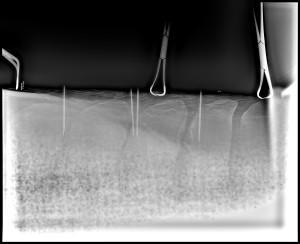
Dr. Davis used sterile surgical equipment, known as a bone rongeur, to elevate the soft tissues and resect some of the affected dorsal spinous processes (DSPs). The rongeurs, which are similar to large pliers, were used to slowly remove the edges of the overriding bone. This process frees the space between adjacent vertebrae until widened enough that the index finger of the surgeon could easily pass in the interspinous space. The site of resection was lavaged to remove any loosed tissues. Lastly, Intra-operative radiography was used as needed to confirm the location and completion of the surgery. Following confirmation, the supraspinous ligament was internally closed with absorbable sutures. The skin was closed with surgical staples and a stent was sutured in place over the incision. After several weeks of healing, the stent and staples were removed.
The kissing spines surgery was performed without complication and Blessing was provided a good prognosis. Soon after surgery, the space that was created between vertebrae filled with a non-painful, fibrous scar tissue. Blessing went home the following day after surgery. She was monitored closely at home and received routine peri-operative antibiotics (gentamicin and penicillin) and anti-inflammatories (phenylbutazone) for pain. Recently, O’Neal was given the okay from Dr. Davis to resume riding for normal exercise. O’Neal looks forward to continuing her partnership with this special mare. Thanks to Dr. Weston Davis and the team at Palm Beach Equine Clinic for their exceptional care to get Blessing back to happy and healthy!
Learn More About Dr. Kathleen Timmins
Dr. Kathleen A. Timmins is a 1993 graduate of the Ohio State University School of Veterinary Medicine. She completed her internship in equine medicine and surgery at the Illinois Equine Hospital near Chicago. Prior to coming to Florida, Dr. Timmins practiced in Aiken, South Carolina, where she met her husband, John Gobin, who plays polo professionally. Growing up in Central Ohio, Dr. Timmins began her relationship with horses as a child on the hunter/jumper circuit. She and her husband are enjoying parenthood with their daughter Schuyler.
Will you tell us more about your background riding on the hunter/jumper circuit?
I grew up in a family who was not involved with horses. At nine years old, I began showing in the hunters/ equitation locally in central Ohio and continued to ride until I went to college. I was fortunate enough to have a couple of nice junior Thoroughbred horses to show. I unfortunately don’t ride very much anymore. I have passed the reins over to my daughter, Schuyler. My daughter began riding at a young age on a medium pony that she has since outgrown. Schuyler is now 13 years old and rides a really nice green hunter. My husband is also a polo player, so she has been fortunate to have grown up with horses her entire life.
Were you involved with polo before you met your husband? How involved are you with the sport in Wellington?
I was working in Aiken when I met my husband. I came to Wellington with my husband in 1996 and that was also the year I started working for Palm Beach Equine Clinic. I currently have a nice mix of clientele in all disciplines located in both the Wellington/Virginia areas. My clients are mainly show horses; however, I do have many polo ponies as patients. I am also a member on the USPA (United States Polo Association) Equine Welfare Committee and Drugs & Medication sub-committee that authored the USPA Drugs & Medications Rules Book which was implemented a few years ago.
What do you enjoy about being part of the team at PBEC?
I love working at Palm Beach Equine Clinic. All the Doctors and staff are very supportive of each other and always willing to help. All the doctors have our own area of expertise and everyone is always willing to work as a team when necessary. There are many employees that have been there for many years. Additionally, I love having all of the technology available to help with all my veterinary cases. I have worked as an ambulatory tech practitioner in the past where I have had to refer cases to the local hospital. I like being on the referral end and receiving cases to help with rather than having to send clients off for various reasons.
When and why did you decide to become a veterinarian?
I was the kid following the vet around the barn when I was young. I was always seriously interested in the sciences and animals; combining the two passions seemed like a natural progression. I just came home one day and said to my mom, ‘I applied to vet school.’ I have never regretted my decision!
Do you have a specialty or main focus?
In my practice, I do a little bit of everything, but I enjoy the challenge of the difficult medical cases the best. I take many of the patients that enter the hospital, including the seriously ill ones such as pneumonias, colitis, kidney failures, or colics; the types of cases that require problem solving. At Palm Beach Equine Clinic Hospital, I can closely manage their care every day to hopefully recover successfully. I also like working with the geriatric animals. We have seen an increase in the senior performance animals and I enjoy working to keep them comfortable and happy.
Who has been the biggest influence in your life or career? What did they teach you?
It really hasn’t been any one person who influenced my career, it has been many. The truth is, you learn something or gain something from everyone, good, bad or otherwise. There are always lessons to be learned and you are always influenced a little bit by everybody in your life.
What are some of your other hobbies or interests?
During the summers when school lets out in Florida, my family travels to Middleburg, Virginia. My husband runs Great Meadow Polo Club and also has a polo school up there. I help him with the club when I’m there. I am licensed in VA so I can still work with my clients from the clinic there. We also travel to Aiken as we have a farm and clients there, but we don’t get there very often as we are so busy with the club in VA.
What is one of the most interesting cases you have worked on?
Recently, I had a racehorse filly with a case of multidrug-resistant pneumonia that was really tough to treat. Our team had to think outside the box from normal procedures to treat her, but it was successful! She recovered fully from her aggressive case of pneumonia and went home to her owners. In today’s veterinary world, horses, like people, are contracting these drug-resistant bacteria as well.
If you were not a vet, what would you be doing?
I would be a chef and run my own restaurant. I really love to cook, it is a passion of mine!
Is there anything else that people would like to know about you?
I am an FEI Veterinary Delegate for the past 10 years. I have many close contacts within the FEI and I am knowledgeable with all of their up to date rules. An FEI veterinarian is present at the shows to monitor the care of the horses.
Q&A with Dr. Bryan Dubynsky

Get to Know Dr. Dubynsky
Q. Where did you grow up and what is your background with horses?
A. I grew up in Northern Indiana on a horse farm. I was fortunate enough to breed, show in the Midwest circuit, and train our horses.
Q. When and why did you decide that you wanted to become a veterinarian?
A. My father is a physician and I’ve always grown up with an interest in medicine. Choosing to become a veterinarian seemed to be a natural fit combining my love for horses and medicine.
Q. Who has been the biggest influence in your life or career? What did they teach you?
A. I spent my entire childhood from 8 to 18 years old with a third generation horse trainer from Kentucky. He taught me horsemanship and patience of which are two crucial foundations for successfully working around horses every day.
Q. What is your specialty/main focus as a veterinarian?
A. My main focus and interest is sport horse medicine. I love focusing on improving athletic performance and treating horse-related injuries to help clients get their equine partners back to the top!
Q. When did you join Palm Beach Equine Clinic and what do you like about working there?
A. I joined Palm Beach Equine Clinic in 2009. I love working here for the exceptional medical and surgical capabilities and experiences available. I also love the camaraderie of all the employees; we really work as a team! Teamwork is paramount for making the clinic successful.
Q. What is some advice that you would give someone who wants to become a veterinarian?
A. Pick out the top people in the industry and work with them. Learn as much as you possibly can from the people who have been practicing for a long time.
Q. What are some of your other hobbies or interests?
A. Polo, golf, guitar & music, hiking, seeing family and friends. Spending time with my lovely dog, Ginger.
Q. What do you love about your job?
A. I love the opportunities to travel all over the country and Europe to see really cool places to work with my clients. I love working with the competition horses and the atmosphere of high-level competition, as well as caring for the sweet trail horses at home.
Q. What is one of the most interesting cases you have worked on?
A. My horse Batman. He was an abandoned polo pony suffering from West Nile Virus. He was paralyzed for three days and no one wanted to treat him. We treated him with intensive care for three days and used a tractor as a last ditch effort to get him to stand. He has since made a full recovery and is currently playing polo.
The 2015 Pan American Games were held in Toronto, Ontario showcasing exciting equestrian competition in the disciplines of show jumping, dressage and eventing. Countries from North, South and Central America, as well as the Caribbean, fielded teams for the prestigious event which served to secure qualifications for the 2016 Olympic Games in Rio de Janeiro, Brazil. Palm Beach Equine Clinic was proud to have two of its finest sport horse veterinarians in the middle of the action, providing veterinary support to the world’s elite horses.
Palm Beach Equine Clinic’s Dr. Jorge Gomez was in attendance at the Pan American Games to care for many of his competing clients throughout the event. Dr. Gomez is not only a top sport horse practitioner but is also a board-certified surgeon. Dr. Natalia Novoa was also one of the treating veterinarians at the Games, where she provided conventional veterinary services as well as alternative medicine including chiropractic adjustments and acupuncture for many of the equine stars.
Drs. Gomez and Novoa were witness to great sport and tremendous results during their time in Toronto. The show jumping portion of the Games was held July 18-25, awarding medals for individual and team events. Both veterinarians were fortunate enough to watch the Canadian Show Jumping Team win gold. Argentina went home with the silver medal and the United States earned bronze. They also proudly watched several of their own clients earn top finishes in the individual competition. McLain Ward (USA), Andres Rodriguez (VEN), and Lauren Hough (USA) earned the gold, silver and bronze medals respectively.

There is a great deal of work that is vital to maintaining a world class performance horse in peak condition for an event such as the Pan American Games. Dr. Gomez was selected to be the Team Veterinarian for Venezuela and Guatemala. Dr. Gomez teamed up with Dr. Novoa to provide veterinary support for silver medal winner Darlon van Groenhove with Andres Rodriguez (VEN) and sixth place finisher Hardrock Z ridden by Emanuel Andrade (VEN). Dr. Novoa was honored to work with and care for many of the event’s most successful horses, including Canada’s Tripple X III (Tiffany Foster) and Coco Bongo (Eric Lamaze), Argentina’s Abunola (Luis Pedro Biraben) and Cannavara 9 (Matias Albarracin), and Venezuela’s Darlon van Groenhove (Andres Rodriguez), as well as Hardrock Z (Emanuel Andrade).
“Such success is attained with the contributions of a number of people, including the riders, trainers, owners, grooms, veterinarians, farriers and other support personnel, and I wish to take this opportunity to congratulate each and every person involved,” Dr. Novoa stated. “It is my honor and pleasure to provide veterinary care to such top caliber horses. It is truly exciting to watch these athletes compete at the highest level, earning personal bests, such as Andres Rodriguez winning the Individual Silver Medal for Venezuela! Good luck to everyone in the preparations for the Olympic Games in Rio in 2016!”
Palm Beach Equine Clinic, an industry leader in sport horse veterinary care, features a renowned list of veterinarians who are experts in their respective fields, and available to provide services to clientele throughout North America and around the world in the various horse sport disciplines.

